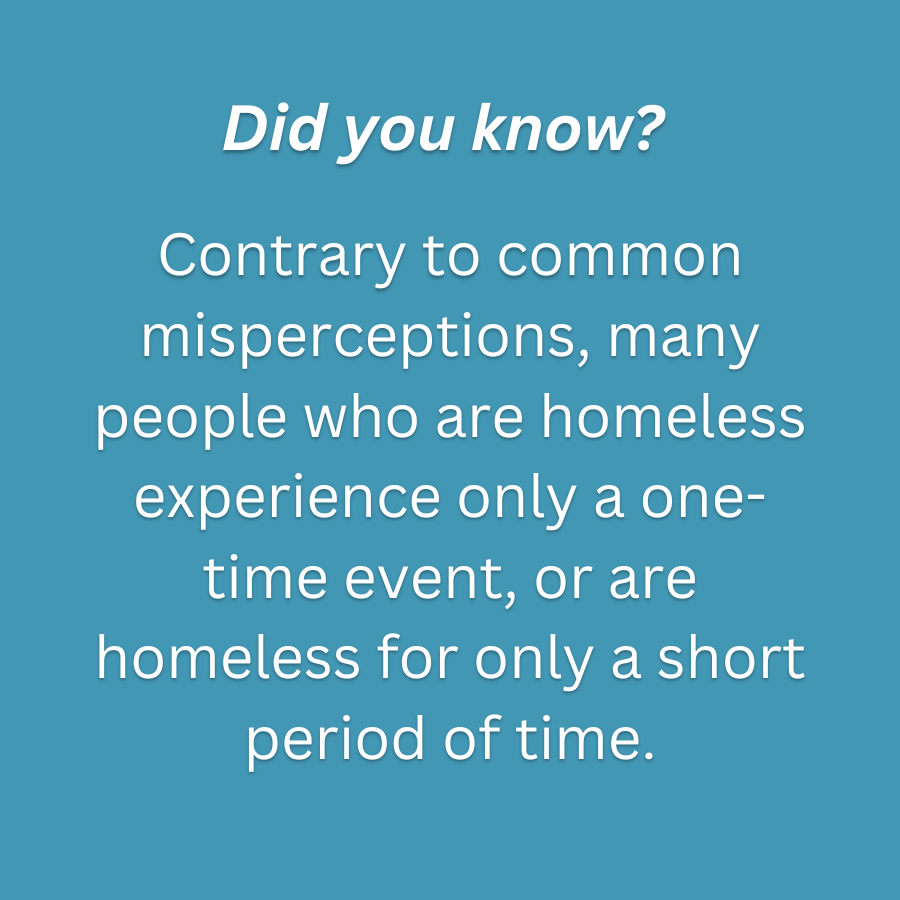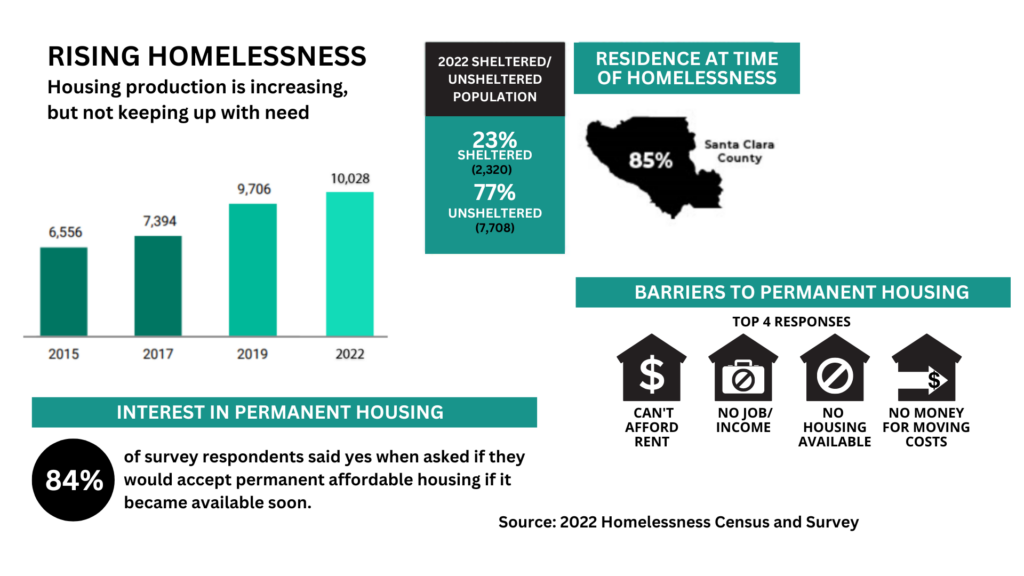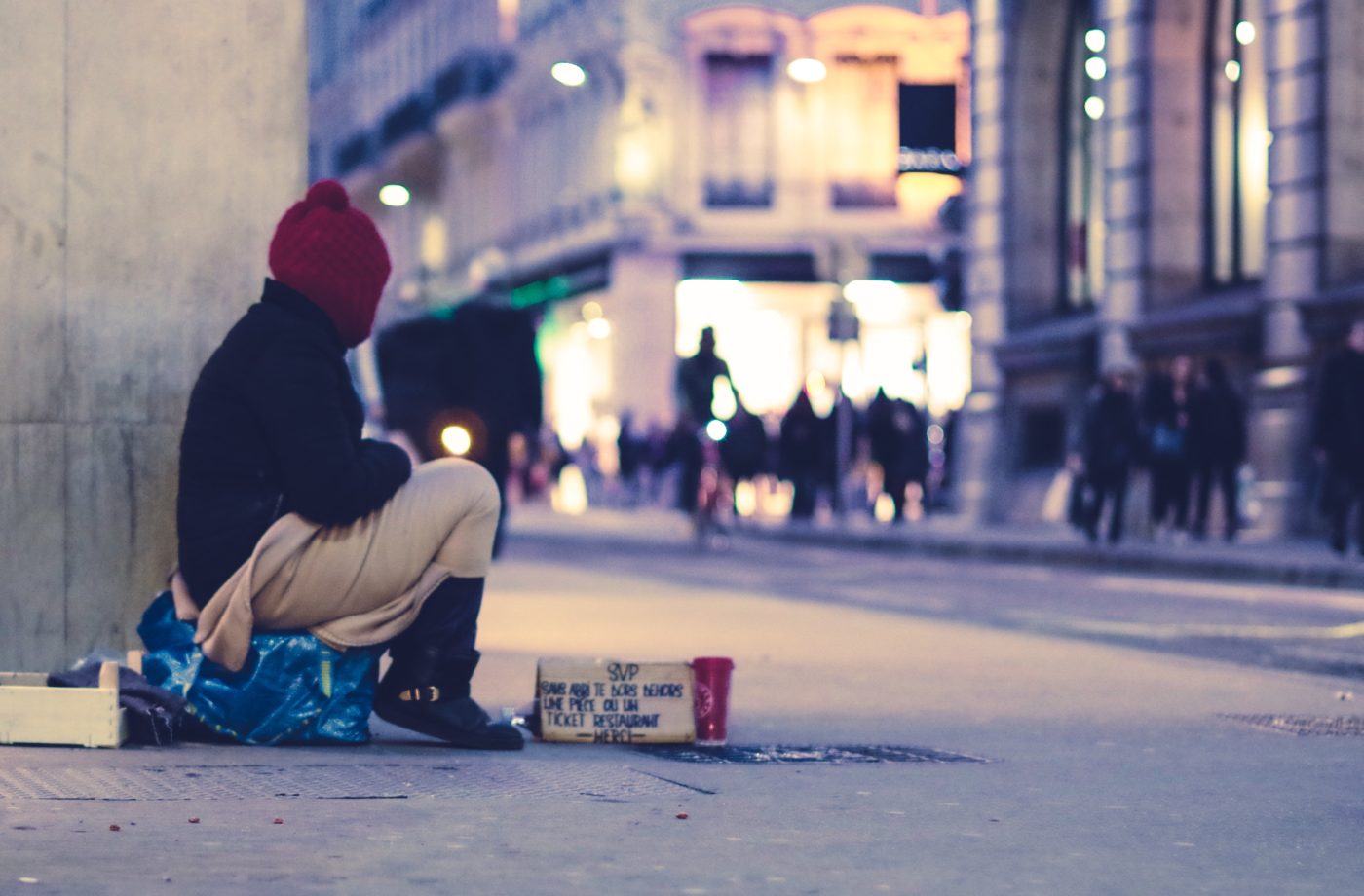According to the 2022 Santa Clara County Homeless Census and Survey (also known as the Homeless Point-in-Time Count), on any given day in Santa Clara County, approximately 10,028 people find themselves without a safe place to stay. When viewed over the course of a year, an even larger number of residents experience homelessness, some for only a few days and some who have been without a stable inside home for years.

Home Not Found, a 2015 study on homelessness in Santa Clara, found that, between 2007 and 2012, about 20 percent of the unhoused population was homeless for only one month and another 32 percent were homeless for two to six months. An estimated 2,169 people in Santa Clara County are considered to be “chronically homeless,” having had long-term or repeated homelessness, coupled with a disability.
Due to the health risks associated with the COVID-19 pandemic, the 2021 Homeless Point-in-Time Count was delayed to 2022. The number of unhoused community members in Santa Clara County remained relatively steady compared to 2019, with the overall number of homeless individuals counted in 2022 increasing 3% in Santa Clara County to 10,028. At the same time, the community saw a decrease in homeless individuals living outdoors, with a 3% decrease in Santa Clara County. More homeless residents were sheltered, as jurisdictions across the community have expanded interim housing and temporary shelter options by 25% in the last three years.

Homelessness exists throughout the county

What can we do? Important Information to Know
From 2020 to 2022, the County’s supportive housing system has helped 6,890 people move from homelessness to stable housing and has prevented homelessness for thousands of households. Over the first five years following passage of the 2016 Measure A Affordable Housing Bond by voters, the County of Santa Clara has committed $588 million to build and renovate nearly 4,500 units in 41 housing developments across eight cities. However, the crisis persists because thousands of residents continue to fall into homelessness each year and more are on the brink of losing their homes – a result of deep, long standing social inequities that include rising economic inequality, federal underinvestment in safety nets, and a lack of affordable housing.
Housing First
Our community embraces the Housing First approach to solving homelessness, focusing on providing permanent housing to individuals and families experiencing homelessness as a first priority, providing tailored services in place according to each person’s individual needs. In recent years, an estimated 85% of all chronically homeless men and women housed through the Housing First approach remain in their new homes.
In 2022, researchers in California announced results from a seven-year randomized trial of chronically homeless individuals in Santa Clara. The study found those in the housing-first group spent 90 percent of their nights housed on average since the study began, and made less use of psychiatric emergency services and more use of outpatient mental health services compared to the control group. “The experiment intentionally sought to try housing first for the very most complicated patients — those who society says are most hard to house — and it worked,” said study co-author Margot Kushel, who directs UCSF’s Benioff Homelessness and Housing Initiative.
Destination: Home
Destination: Home is a public-private partnership overseeing our strategies to end homelessness in Santa Clara County, including creating permanent housing and supportive service opportunities, improving systems of care, and employing strategies that keep individuals and families from becoming homeless.
The Housing Ready Communities initiative is a program facilitated by Destination: Home. It brings together neighbors, community groups, nonprofits, government and housing developers to take action and support approval of new supportive housing and extremely low income affordable housing in Santa Clara County.
Housing Ready Communities are aware of our homelessness crisis, understand that supportive housing is a proven solution to end homelessness, and take action to support new housing development. Housing Ready Communities organize, show up and speak out to dispel myths about homelessness and talk with neighbors about the urgent need for affordable and supportive housing. Learn more, then join the Housing Ready Communities movement today!
Destination: Home’s Board also serves as the HUD Continuum of Care Board for the San Jose /Santa Clara City and County Metropolitan area and works with the Santa Clara County Office of Supportive Housing as a Collaborative Applicant for federal funding.
2020-2025 Community Plan to End Homelessness
Despite progress in Santa Clara County to create a supportive housing system that helps thousands of homeless individuals and families each year, the homelessness crisis continues to grow. The systemic factors driving homelessness in our community, including the lack of housing options affordable for low-income residents, are stronger than ever and push more of our neighbors onto the streets every day. These challenges have been compounded by the COVID-19 pandemic. The 2020-2025 Santa Clara County Community Plan to End Homelessness is the County’s newest roadmap for addressing our homelessness crisis.
Developed by Destination: Home after convening more than 200 stakeholders in a year-long planning process, this second generation Community Plan lays out the roadmap for ending homelessness in the County. Guided by the Housing First approach, it includes three overarching strategies:
- Address the root causes of homelessness through system and policy change
- Expand homelessness prevention and housing programs to meet the need
- Improve quality of life for unsheltered individuals and create healthy neighborhoods for all
When local jurisdictions join the Plan, they become part of a group of community partners that form a continuum of care to address the needs of unsheltered residents. SV@Home is proud to endorse The 2020-2025 Santa Clara County Community Plan to End Homelessness.
2021 Regional Action Plan
In 2020, All Home established the Regional Impact Council (RIC), a nine-county effort, convened to devise a unified effort to address homelessness, establish a more prosperous region, and close racial disparities. The RIC worked to develop immediate solutions that lead with racial equity. The RIC also built solutions holding themselves and their peers to housing standards, increasing accountability for outcomes, and targeting funding and interventions towards the most vulnerable communities.
The RIC has created this ambitious Regional Action Plan to reduce the number of people experiencing homelessness by 75% in three years. In order to house and stabilize our unhoused neighbors while also initiating preventative measures, the RAP defines eight strategic priorities, some of which are already underway.
Learning: Cost of Homelessness Study
In 2015, Destination: Home and the County of Santa Clara released the report “Home Not Found: The Cost of Homelessness in Silicon Valley,” which is considered to be the largest and most comprehensive body of information that has been assembled in the United States to analyze the public costs of homelessness. Among other findings, the study found that the County spent $520 million annually over a six-year period on services to homeless residents. The study showed that, in 2012, while the average annual cost per homeless person was $5,148, top users cost more than $100,000 per year.
Additional Resources
- UC San Francisco Benioff Homelessness and Housing Initiative: California Statewide Study of People Experiencing Homelessness, 2023
- Destination: Home: Understanding Homelessness, 2021
- County of Santa Clara: 2021 Housing Inventory Count, 2021
- County of Santa Clara and Destination: Home: Community Plan to End Homelessness, 2020
- County of Santa Clara: Ending Homelessness 2018 The State of the Supportive Housing System in Santa Clara County, 2019
- Bay Area Council: Economic Institute: Bay Area Homelessness, 2019
- County of Santa Clara: Housing Ready Community’s Toolkit
- County of Santa Clara: Ending Homelessness: The State of the Supportive Housing System in Santa Clara County, 2019-2020
- City of San Jose: Homeless Services Resource Guide, 2017
- SPUR: Homelessness in the Bay Area, The Urbanist, 2017
- US Department of Housing and Urban Development: Defining ‘Chronically Homeless’ Final Rule, 2015
- Economic Roundtable: Home Not Found: The Cost of Homelessness Study, 2015
- Measure A Housing Bond
2019 Homeless Point-In-Time Census and Survey
- County of Santa Clara: 2019 Santa Clara County Homeless Census and Survey Report, 2019
- City of San Jose: 2019 Homeless Census and Survey Documents

